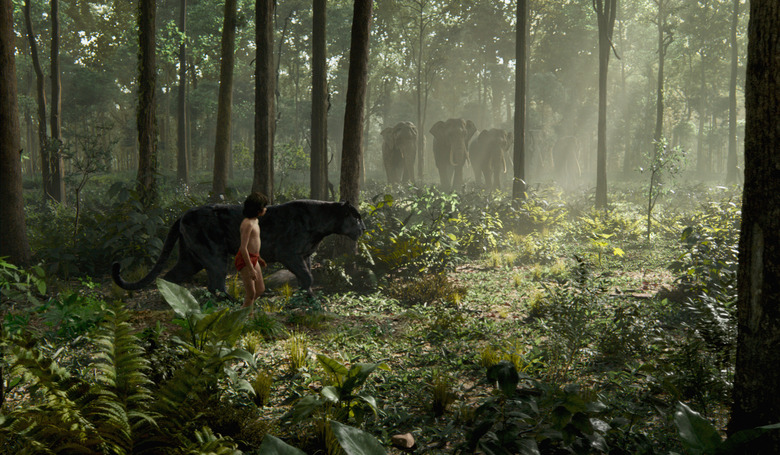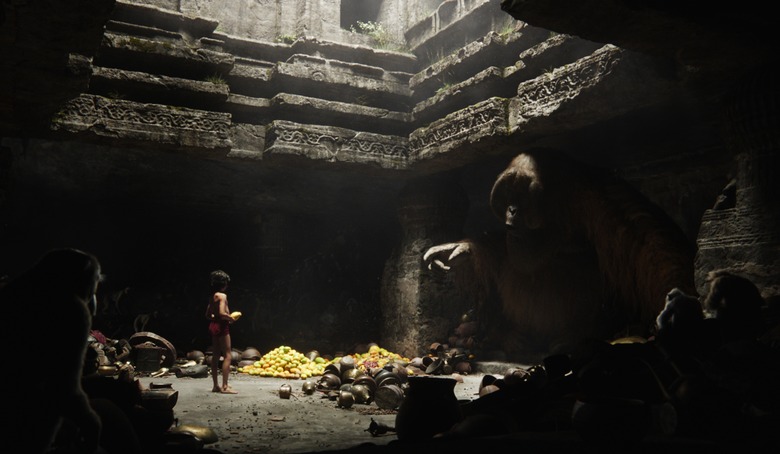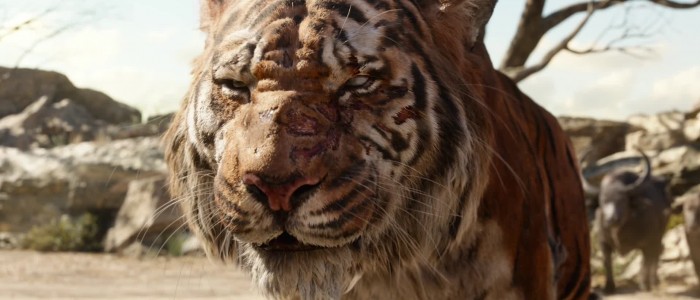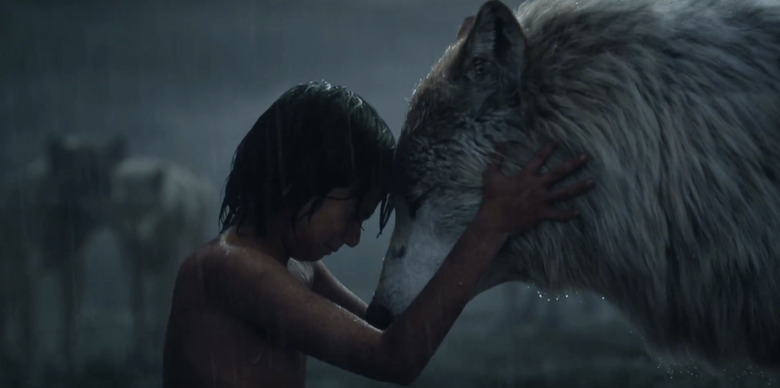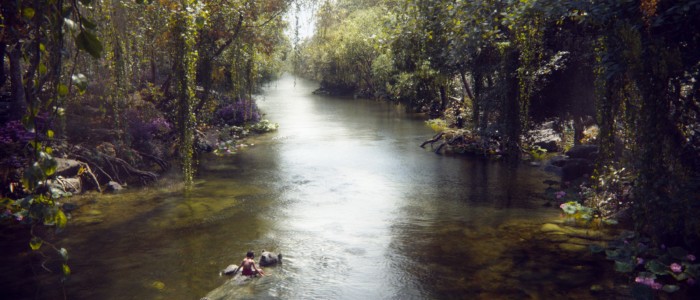'The Jungle Book' Review: How Disney's Latest Live-Action Adventure Justifies The Cinematic Experience
Between Sean Parker's Screening Room and AMC's tentatively proposed (and quickly discarded) texting-allowed policy, we've seen a lot of debate in recent weeks about the sanctity (or lack thereof) of the theatrical experience. Cinephiles will swear up and down that a pristine movie theater is the only proper way to enjoy a movie — and I tend to agree – but the truth is that for a lot of moviegoers, the drawbacks outweigh the benefits. Why fork over $100 for tickets and popcorn and a babysitter, put up with screaming kids and sticky floors, when you can just rent something from the comfort of your own couch? So what if you're missing out on 3D and giant screens and surround sound?
Jon Favreau's The Jungle Book is the answer to that "so what." It's a technical achievement on par with Avatar and Life of Pi, the kind of cutting-edge stunner that actually justifies all the extra premiums and hassles associated with 3D and the theater experience in general. If you're planning to see this movie at all, see it in 3D while it's still in theaters. The film's heart and humor will still be intact when it reaches home video, and thank goodness for that, but the magic of its special effects is on another level altogether.
Reimagining an Animated Classic
The Jungle Book is the latest entry in Disney's ongoing series of live-action reboots of its own animated classics, following Alice in Wonderland, Maleficent, and Cinderella. It's based on the stories of Rudyard Kipling, but it's really modeled after the studio's 1967 animated adaptation of same. Neel Sethi plays Mowgli, a "man-cub" raised by the wolves Raksha (voiced by Lupita Nyong'o) and Akela (Giancarlo Esposito). Although the jungle is the only home he's ever known, he's forced to return to the "man-village" when the tiger Shere Khan (Idris Elba) demands the wolf pack hand over Mowgli on pain of death.
So Mowgli sets out on a journey, accompanied by his panther friend Bagheera (Ben Kingsley). Although Favreau's new version takes some liberties with the storyline (the ending is notably different), it hits most of the same beats. Mowgli still has run-ins with Kaa (Scarlett Johansson) and King Louie (Christopher Walken), he still befriends Baloo (Bill Murray), and so on. The new Jungle Book even nods to the old Jungle Book's signature tunes "Bare Necessities" and "I Wan'na Be Like You," with mixed results. They're too memorable a part of the original to scrap altogether, but their goofy spirit is an odd fit for the otherwise naturalistic movie. The half-assed versions sung by Murray and Walken feel more dutiful than heartfelt.
An Eye-Popping, Jaw-Dropping Technical Achievement
The Jungle Book impresses before it even properly begins, as the familiar Disney castle recedes into the distance while we pull back into the jungle. We then hit the ground running, quite literally, following Mowgli as he races through the jungle with wolf cubs nipping at his heels. We're with him for every swing from a vine and jump off a log. Already, it's shocking how photo-real the animation looks. If I hadn't known The Jungle Book was shot almost entirely on soundstages in downtown Los Angeles, I'd be marveling at the location scouts' discovery of an untouched paradise and the animal wranglers' uncanny talent for getting these beasts to perform on cue. In truth, only Sethi is "real"; all the animals and the settings were crafted in CG by the wizards at MPC and Weta.
Favreau uses 3D to add depth to the picture, rather than to send things flying in toward the audience. The impression we're left with is that we're peering out a giant window into a thick jungle, and it's further underlined by one shot in which a few stray "water droplets" land on the "camera." And instead of using CG magic to show us impossible things, he uses them to replicate the natural world. Knowing how much of The Jungle Book was done on computers, I couldn't resist looking for the seams. I found none, or close enough to it. The team has accounted for every detail, from the weight of the animals as they walk and the counterweight of the ground as it pushes back, to every tiny twitch of an ear or ripple of the fur. Even the mouth movements of the animals as they speak, somehow work. It takes little effort on the part of the viewer to believe a tiger really has the voice of Idris Elba, or a wolf talks like an American-accented Lupita Nyong'o.
This vivid photo-realism adds an extra level of grittiness to the movie's action sequences, which are as well choreographed and well shot as any blockbuster climax. A stampede cribbed straight from The Lion King skips the most traumatic part (Mufasa's death — uh, spoiler alert) but doubles down on the panic of being a tiny body lost among violently thundering masses. While The Jungle Book is not a scary movie per se, the shocks are visceral enough that parents of very young children might want to leave them at home.
Idris Elba's Shere Khan Dominates an All-Star Cast
The Jungle Book has a voice cast to rival any blockbuster franchise or ensemble prestige drama's, and all of them bring their A-game. Their efforts, however, do not all pay off equally. By far the best performance in the movie is Elba's as Shere Khan. He radiates menace, and the low rumble of his voice melds seamlessly with the roars of a tiger. Elba boasts a commanding presence even in his warmest roles, so it naturally follows that he makes for an imposing villain. But Elba, and Justin Marks' screenplay, give the character a much-needed depth. Part of what makes Shere Khan so terrifying is that he's not driven by some abstract desire for power or taste for destruction — the conflict is deeply personal to him, and that only makes him seem more dangerous and more determined. Disney could teach their Marvel Studios brethren a thing or two about crafting believable and compelling supervillains.
Kingsley also acquits himself quite nicely, disappearing into the role of Bagheera, and Murray is such a perfect fit for Baloo that even though it's impossible to forget whose voice we're listening to, it's easy to believe him as a big, lazy bear. On the flip side, Walken proves a little too distinctively oddball for the role of Louie — a problem exacerbated by the decision to make Louie look like Walken as well as sound like him — and Johnasson isn't onscreen long enough for us to reconcile the weirdness of hearing this A-list actress' husky voice slink forth from the lips of a cobra.
As for Sethi, the only non-animated member of the Jungle Book cast, he acquits himself pretty nicely for a preteen. His line readings are occasionally exaggerated (as tends to be the norm for child actors), but he's got enough charisma to smooth over any shortcomings. Even more crucially, he's a natural as a physical actor. As Mowgli, he moves like a kid who grew up wild — he has the fluidity of someone who never stops moving, and the grace of someone utterly comfortable in his own skin.
Mowgli's Journey Is the Beating Heart
While the film's visual achievements and rockstar cast are its most marketable attributes, it's clear Marks and Favreau haven't slouched on the underlying emotion, either. The Jungle Book is a rock-solid coming-of-age tale, brimming with the excitement and the terror and even the sadness of growing up. As a man-cub among animals, Mowgli's never quite fit in — "I realize you weren't born a wolf, but can't you at least act like one?" sighs an exasperated Bagheera at one point — but the jungle is still home. It's not until Shere Khan arrives that Mowgli is shaken out of his complacency, and forced to confront his own identity. Is he truly one of the wolves, who've loved him and cared for him since infancy? Or is he a man who belongs in the man-village, brandishing the "red flower" (fire) that the other animals regard with awe and fear?
Mowgli's journey of self-discovery is sometimes subdued in favor of more thrilling setpieces or more cutesy gags, but it's a thread that runs through the entire movie. Mowgli's human-ness is what makes him special, but it's also what makes him strange and even threatening to his own animal community, who see humans as a threat. Mowgli's reasons for wanting to return to the man-village — and Bagheera's for encouraging and guiding him — are sound, but the film makes a point of acknowledging what Mowgli stands to lose. "They'll ruin him. They'll make a man out of him," protests Baloo when Bagheera tells him of his plan. It's hard not to think that Baloo has a point, and when the tension between Mowgli's human and animal sides comes to a head in the third act, it's a surprisingly heart-wrenching moment.
The Singular Magic of Going to the Movies
All of my memories of watching the 1967 Jungle Book involve living rooms — growing up, I only ever watched it on VHS tapes, at my own childhood home or someone else's. No doubt countless kids will experience Favreau's new Jungle Book the same way, playing it over and over from their parents' iTunes accounts. And it's a film that deserves to be treasured that way. Mowgli's arc should resonate across the ages, and friendly talking animals never seem to go out of fashion. The painstaking visuals will still look lush and vibrant on a TV set or a tablet or a smartphone screen, and maybe one day we'll be reminiscing fondly about this film as the start of Sethi's illustrious career.
But these kids will be missing the extra layer of magic that bumps up The Jungle Book from a sturdy remake to a must-see spectacle — the how-did-they-do-it amazement of seeing it on a giant screen, where you can see each fluttering blade of grass and each trembling breath from the snout of a wolf. Not to mention the experience of watching a vibrant fantasy unfold like it's happening mere inches in front of you, even as your brain knows you're really just looking at pixels laid atop many, many hours of footage of a little boy leaping across green screens. The Jungle Book won't "save" moviegoing; no one movie can. But it makes a strong case, to serious cinephiles and casual consumers alike, that the experience is one worth saving.
/Film rating: 8.0 out of 10

